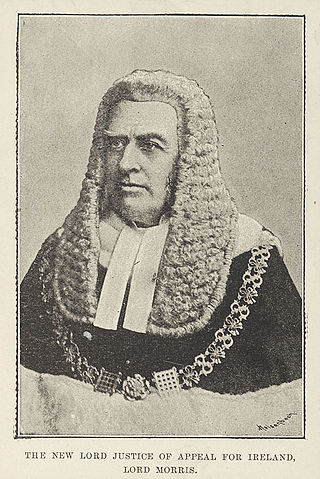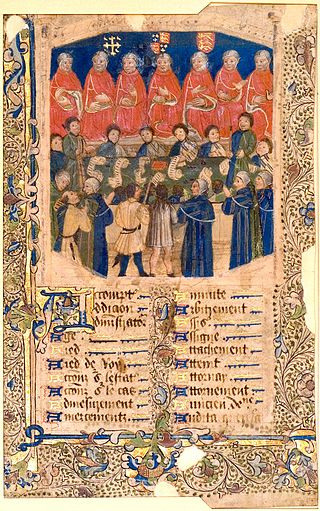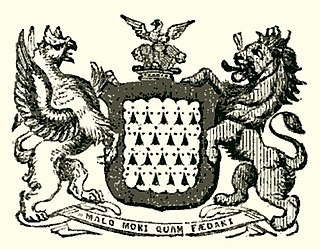
In the field of jurisprudence, equity is the particular body of law, developed in the English Court of Chancery, with the general purpose of providing legal remedies for cases wherein the common law is inflexible and cannot fairly resolve the disputed legal matter. Conceptually, equity was part of the historical origins of the system of common law of England, yet is a field of law separate from common law, because equity has its own unique rules and principles, and was administered by courts of equity.

A consistory court is a type of ecclesiastical court, especially within the Church of England where they were originally established pursuant to a charter of King William the Conqueror, and still exist today, although since about the middle of the 19th century consistory courts have lost much of their subject-matter jurisdiction. Each diocese in the Church of England has a consistory court.

The Attorney-General for Ireland was an Irish and then United Kingdom government office-holder. He was senior in rank to the Solicitor-General for Ireland: both advised the Crown on Irish legal matters. With the establishment of the Irish Free State in 1922, the duties of the Attorney-General and Solicitor-General for Ireland were taken over by the Attorney General of Ireland. The office of Solicitor-General for Ireland was abolished at the same time for reasons of economy. This led to repeated complaints from the first Attorney General of Ireland, Hugh Kennedy, about the "immense volume of work" which he was now forced to deal with single-handedly.
Sir Cresswell Cresswell, PC, born Cresswell Easterby, was an English lawyer, judge and Tory politician. As a judge in the newly created divorce court, Cresswell did much to start the emergence of modern family law by setting divorce on a secular footing, removed from the traditional domain of canon law.

The Chancellor of the High Court is the head of the Chancery Division of the High Court of Justice of England and Wales. This judge and the other two heads of divisions sit by virtue of their offices often, as and when their expertise is deemed relevant, in a panel in the Court of Appeal. As such this judge ranks equally to the President of the Family Division and the President of the King's Bench Division.

Colin Blackburn, Baron Blackburn, was a British lawyer and judge. The son of a Scottish clergyman, he was educated in Scotland and England, before joining the English bar. He was little known to the legal world before he was elevated from the junior bar to a puisne judgeship in the Court of Queen's Bench by Lord Campbell in 1859, a position he held until 1876, when he was appointed to the Court of Appeal. In October of that year, he was the first person to be appointed as a law lord under the provisions of the newly enacted Appellate Jurisdiction Act. He retired in 1886 and died ten years later. Blackburn was considered the highest authority on common law and his judgments continue to be cited today.
The Incorporated Council of Law Reporting for England and Wales (ICLR) is a registered charity based in London, England, that publishes law reports of English law. The company is widely recognised as a reputable producer of reports, which are used by students, academics, journalists, lawyers and judges across the country.
The Chancellor of the Exchequer of Ireland was the head of the Exchequer of Ireland and a member of the Dublin Castle administration under the Lord Lieutenant of Ireland in the Kingdom of Ireland. In early times the office was sometimes called the Chancellor of the Green Wax. In the early centuries, the Chancellor was often a highly educated cleric with knowledge of Finance. In later centuries, when sessions of Parliament had become regular, the Chancellor was invariably an MP in the Irish House of Commons. Walter de Kenley, Chancellor from 1292 until his death, was both a judge of the Court of Common Pleas (Ireland) and a distinguished military commander who gave good service against the Gaelic clans of County Wicklow.

The Court of Common Pleas, or Common Bench, was a common law court in the English legal system that covered "common pleas"; actions between subject and subject, which did not concern the king. Created in the late 12th to early 13th century after splitting from the Exchequer of Pleas, the Common Pleas served as one of the central English courts for around 600 years. Authorised by Magna Carta to sit in a fixed location, the Common Pleas sat in Westminster Hall for its entire existence, joined by the Exchequer of Pleas and Court of King's Bench.
Richard Vaughan Barnewall was an English lawyer and law reporter.
The Law Reports is the name of a series of law reports published by the Incorporated Council of Law Reporting.

John Barnewall, 3rd Baron Trimleston, was an Irish nobleman, judge and politician. He was the eldest son of Christopher Barnewall, 2nd Baron Trimlestown and his wife Elizabeth Plunket, daughter of Sir Thomas Fitz-Christopher Plunket of Rathmore, Lord Chief Justice of the King's Bench in Ireland and his second wife Marian Cruise. He succeeded his father as 3rd Baron in about 1513. His father, like most of the Anglo-Irish aristocracy, had supported the claim of the pretender Lambert Simnel to the English throne in 1487. After the failure of Simnel's rebellion, he received a royal pardon.
Thomas Flower Ellis, was an English law reporter.
Patrick Barnewall was a leading figure in the Irish Government of the 1530s and 1540s. He owed his position largely to his close links with Thomas Cromwell. He sat in the Irish House of Commons as MP for County Dublin, and held the offices of Solicitor General for Ireland and Master of the Rolls in Ireland. Today he is mainly remembered for his role in founding the King's Inns. He belonged to a junior branch of the family of Lord Trimlestown: his own descendants held the title Viscount Barnewall of Kingsland.
Sir James Dowdall was an Irish judge of the Elizabethan era who briefly held office as Lord Chief Justice of Ireland. He should not be confused with James Dowdall, the Catholic martyr, who was his cousin.
William Newland Welsby was a legal writer who was born in Acton, Cheshire about 1802, was the only son of William Welsby of the Middle Temple, gentleman.

Sir John Jackson Smale was a British lawyer and judge. He served as Attorney General and the longest-serving Chief Justice of Hong Kong.
SIr George Markham Giffard, PC was an English barrister and judge.
George Wirgman Hemming, KC (1821–1905) was an English law reporter and barrister.

Sir John Peter De Gex (1809–1887) was an English barrister and law reporter.








